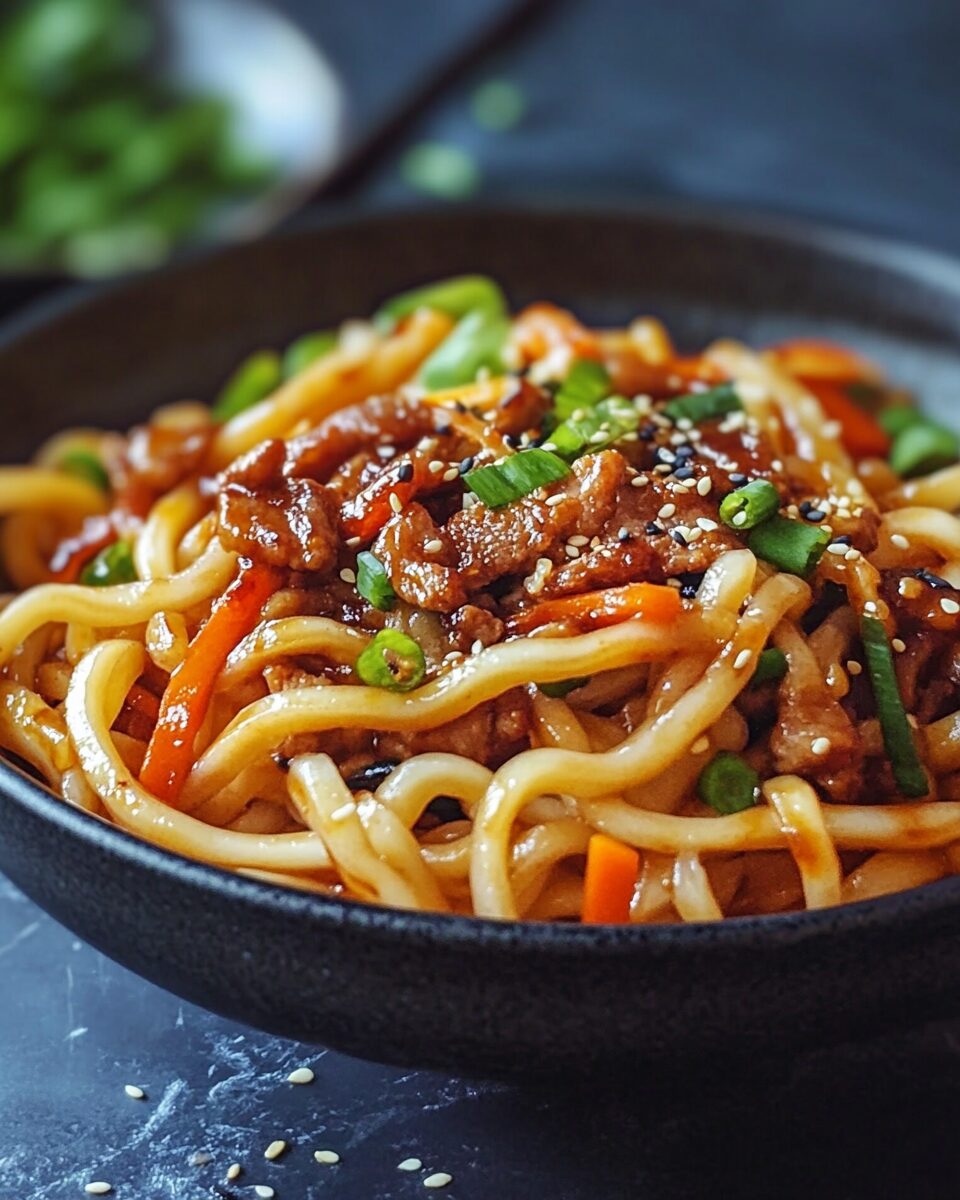Bulgogi Pork Udon is a delightful fusion dish that combines the rich, savory flavors of Korean-style marinated pork (bulgogi) with the chewy texture of Japanese udon noodles. This hearty meal offers a satisfying blend of tastes and textures, making it a perfect choice for dinner.
FULL RECIPE:
Ingredients
For the Bulgogi Marinade:
- 1 pound pork tenderloin, thinly sliced
- 1 small pear, peeled and grated
- 2 green onions, minced
- 4 cloves garlic, chopped
- 3 tablespoons soy sauce
- 2 tablespoons brown sugar
- 1 tablespoon sesame oil
- 1 tablespoon rice wine vinegar or sherry wine vinegar
- 1 teaspoon sesame seeds
- 1 teaspoon crushed red pepper flakes
For the Udon Noodles:
- 14 ounces (400 grams) fresh or frozen udon noodles
- 1 medium onion, thinly sliced
- 1 medium carrot, julienned
- 2 tablespoons vegetable oil
- 2 tablespoons soy sauce
- 1 tablespoon sesame oil
- 2 green onions, chopped (for garnish)
- Sesame seeds (optional, for garnish)
Directions
- Marinate the Pork:
In a bowl, combine grated pear, minced green onions, chopped garlic, soy sauce, brown sugar, sesame oil, rice wine vinegar, sesame seeds, and crushed red pepper flakes. Mix well. Add the thinly sliced pork to the marinade, ensuring each piece is well-coated. Cover and refrigerate for at least 30 minutes, or overnight for deeper flavor. - Cook the Udon Noodles:
Bring a large pot of water to a boil. Add udon noodles and cook according to package instructions until just tender. Drain and set aside. - Stir-Fry the Pork and Vegetables:
Heat 1 tablespoon of vegetable oil in a large skillet or wok over medium-high heat. Add the marinated pork and stir-fry until it’s about 70% cooked, approximately 7-10 minutes. Add the sliced onion and julienned carrot to the skillet. Continue cooking until the vegetables are tender and the pork is fully cooked. - Combine with Noodles:
In the same skillet, push the pork and vegetables to one side. Add the remaining tablespoon of vegetable oil to the empty side and add the cooked udon noodles. Pour soy sauce and sesame oil over the noodles. Toss everything together until the noodles are well-coated and heated through, about 1-2 minutes. - Serve:
Transfer the bulgogi pork udon to serving bowls. Garnish with chopped green onions and sesame seeds if desired. Serve hot.
Nutrition Facts
- Calories: 680 kcal
- Total Fat: 18g
- Saturated Fat: 3.5g
- Cholesterol: 85mg
- Sodium: 1040mg
- Total Carbohydrates: 98g
- Dietary Fiber: 5g
- Sugars: 14g
- Protein: 36g
The Fusion of Korean and Japanese Flavors
Bulgogi Pork Udon is an incredible dish that brings together the savory sweetness of Korean bulgogi with the chewy delight of Japanese udon noodles. This unique combination offers a cultural blend that makes the meal not only delicious but also exciting for those who appreciate Asian cuisine. The fusion of flavors and textures creates a comforting yet sophisticated dish that is ideal for both casual meals and special occasions. The traditional Korean bulgogi, which means “fire meat,” is typically made by marinating thinly sliced pork or beef in a sweet and savory sauce. This sauce often consists of soy sauce, brown sugar, garlic, sesame oil, and other seasonings.
Why Bulgogi Pork Udon Stands Out
What sets Bulgogi Pork Udon apart is its perfect balance of flavors. The marinade’s sweetness complements the savory soy sauce and the natural richness of the pork. The thick udon noodles soak up the sauce, making each bite full of flavor. The combination of tender meat, chewy noodles, and crisp vegetables adds both texture and depth to the dish. Additionally, the caramelization of the pork during cooking introduces a smoky, grilled essence that enhances the overall taste. The versatility of Bulgogi Pork Udon is another reason it has become so popular. While the recipe traditionally uses pork, it can be easily adapted to include other proteins like chicken, beef, or tofu. Vegetables can also be customized based on personal preference or seasonal availability. This adaptability makes it a go-to choice for busy weeknights or when hosting guests.
Nutritional Value and Balanced Eating
Bulgogi Pork Udon is a nutrient-dense meal that provides a good balance of macronutrients. The lean pork offers high-quality protein, which is essential for muscle growth and repair. Udon noodles, made from wheat flour, supply complex carbohydrates that serve as a primary energy source. Vegetables like carrots, onions, and bell peppers add fiber, vitamins, and antioxidants, further contributing to a well-rounded meal. The dish is also an excellent source of iron and zinc, which are vital for maintaining energy levels and supporting immune function. Additionally, garlic and onions provide compounds that support heart health and offer anti-inflammatory benefits. For those seeking a lower-sodium option, reduced-sodium soy sauce can be used without compromising the dish’s signature flavor.
Tips for Customizing Your Bulgogi Pork Udon
Customization is one of the key advantages of this dish. Adjusting the sweetness of the marinade can be done by increasing or decreasing the brown sugar, honey, or grated pear. For those who enjoy a spicier meal, adding gochujang or red pepper flakes can provide a satisfying heat. Vegetables such as zucchini, mushrooms, or spinach can be substituted or added for extra nutrition and variety. Another option is to change the protein source. While pork is traditional, beef is an equally delicious choice. For a lighter alternative, chicken or tofu can be used. Tofu, in particular, absorbs the marinade well, resulting in a flavorful vegetarian version of the dish. By experimenting with different proteins and vegetables, Bulgogi Pork Udon can be tailored to suit a range of dietary preferences and tastes.
Serving Suggestions
Bulgogi Pork Udon is a versatile meal that can be enjoyed on its own or paired with side dishes for a complete dining experience. For a balanced meal, consider serving it alongside a crisp cucumber salad or a traditional Korean kimchi. The tanginess of kimchi complements the richness of the pork, while a side salad adds a refreshing contrast. Another excellent addition is a bowl of miso soup, providing a light and comforting element that rounds out the meal. For those looking to enhance the presentation, garnishing the dish with sesame seeds and freshly chopped green onions adds color and texture. A drizzle of additional sesame oil can also elevate the dish’s aroma and flavor.
Storing and Reheating
Leftover Bulgogi Pork Udon can be stored in an airtight container in the refrigerator for up to three days. When reheating, using a skillet over medium heat is the best option. Adding a small amount of water or broth will help loosen the sauce and prevent the noodles from drying out. This method maintains the dish’s original texture and flavor. Avoid microwaving if possible, as it can lead to uneven heating and rubbery noodles. For meal-prepping purposes, the pork and vegetables can be marinated and stored separately from the noodles. This allows for easy assembly and fresher results when ready to cook. Freezing is not recommended due to the udon noodles’ tendency to become mushy upon thawing.
Health Benefits of Key Ingredients
Pork is an excellent source of protein, iron, and B vitamins, which support energy production and muscle maintenance. Lean cuts like pork tenderloin are low in saturated fat, making them a heart-healthy option when consumed in moderation. Udon noodles, while primarily a source of carbohydrates, provide energy for daily activities and are low in fat. Choosing whole wheat or fiber-enriched udon noodles can further enhance the dish’s nutritional value. Garlic and onions offer numerous health benefits, including anti-inflammatory properties and immune support. They contain sulfur compounds that promote cardiovascular health. Soy sauce, though high in sodium, can be used in reduced amounts or replaced with a lower-sodium alternative without sacrificing flavor.
Cultural Significance
Bulgogi has deep roots in Korean culture, often enjoyed at family gatherings and festive occasions. It is traditionally cooked over an open flame, resulting in its signature smoky flavor. Combining this traditional Korean dish with Japanese udon represents the beauty of culinary fusion, bridging two distinct cultures through food. Udon noodles, originating in Japan, are a symbol of comfort and simplicity. They are often served in a variety of dishes, from brothy soups to stir-fries. Pairing udon with bulgogi not only introduces an exciting twist but also celebrates the harmonious relationship between these two cuisines.
Conclusion
Bulgogi Pork Udon is a meal that offers a rich tapestry of flavors and textures, making it a delightful addition to your recipe collection. Its versatility and nutrient-packed ingredients ensure that it satisfies both the palate and the body. Whether served for a family dinner or a special occasion, this fusion dish is sure to impress. Embrace the bold flavors of Korea and the comforting essence of Japan in one delicious bowl.






